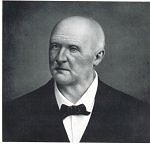Coupling one of Mozart's sunniest concertos against the richest of Bruckner's symphonies was rather like moving between the seasons in one evening. Summer moved on to autumn, and this great orchestra changed with it, taking us with them on this very special pilgrimage.
The A major concerto, K488 is one of Mozart's most beguilingly lyrical and the Concertgebouw played with a lightness of touch that seemed echt Mozartian. Rhythm and articulation were naturally focussed, Chailly directing his players with the minimal of direction, the spring in his step so carefully taken up by the orchestra. Woodwind blended exquisitely, the oboe and flute in the second movement exchanging their bars with marvelous expressiveness. In the midst of this, Andreas Haefliger's playing seemed decidedly heavy. The first movement cadenza moved between nimble-fingered dexterity and playing of quite phenomenal depth. Whilst it lasted it was mesmerising. The opening of the second movement adagio was almost Schubertian (surely not what Mozart would have wanted), but the poignency of the movement remained somewhat under-developed. One wondered whether Haefliger knew this was only the second and last of the adagios Mozart wrote for the piano concertos: he certainly gave the impression of never wanting to end it. The third movement was magical, both Haefliger and the orchestra alive to the delicious lyricism of Mozart's scoring. But on this showing, it is Chailly who seemed the natural Mozartian.
Chailly's pacing of Bruckner's great Seventh is uneeringly natural. That he has an orchestra tutored in Bruckner (from Van Beinham through to Haitink) is an advantage few conductors are able to afford, and he makes the most of it. The playing was little short of fabulous, the strings particularly impressive. Indeed, in the great opening bars of the first movement the tremolo on strings had a singularity that belied the fact you were listening to a symphony orchestra. Time and time again, one was aware of an almost Bachian resonance to the playing. The cellos arched upwards through two whole octaves in a symbiotic way I have never heard before, their tone as burnished as dark wood. The sonority they produced was staggering, and if they seemed the heart and soul of this orchestra it was left to the brass during the great C minor eruption to lead the way with playing of magisterial breadth. The coda was catastrophic: timpani beginning to roll onwards, the mighty crescendo underpinned by some of the most exhilirating brass playing you could ever hope to hear. This whole movement was a supreme achievement, having about it a Celibidache-type clarity of textures that made you hear Bruckner's scoring with fresh ears.
Chailly's view of the adagio is not perhaps as death-drenched as some, but it is still a monumental creation. The string sound moved between the peaks of desolation and solemnity in great swathes of richness. The Wagner tubas (intonation not always spot-on) produced a sound like plush velvet. This movement progressed almost organically, the contrast between the opening lament and the pacing to triple time that lightens the mood taken naturally. Many magical things were created: a flute that floated delicately over the orchestra, strings that hovered above the stave in a state of anguish and a cymbal clash and triangle roll that were perfectly timed. The coda, placed as a tribute to Wagner, was here a sublime end to the movement, the pianissimo held breathlessly to the movement's closing threnody.Both the scherzo and final movement (with a combined time shorter than either of the first two movements) were near perfectly realised by Chailly. The scherzo was brisk, the last movement almost Haydanesque in its vigorousness. The dynamic range was extraordinary, with the loudest fff and most silent ppp clearly etched on the memory. The final peroration on brass and massed strings was given the most monumental of build-ups, the symphony ending sonorously.
This concert will leave a lasting impression on those who heard it. One only hopes we will hear more of the Concertgebouw in London, for such playing is not an everyday experience.
Marc Bridle
This concert will be broadcast on Radio 3 on Monday 7 February at 7.30pm.


 Return to:
Return to: